
White spots on the face in children
nathaniclinic1
July 24, 2023

Caregivers tend to panic when seeing white spots on their children’s faces. We also see these lesions in adolescents because of acne; in some cases, they result from post-inflammatory depigmentation. Vitiligo, fungal infections, and vitamin deficiencies cloud their minds, and the parents reach out to their pediatricians in a panic.
The most common cause of white spots on children’s faces is “Pityriasis Alba” – Alba, as the name suggests, is white, and pityriasis refers to the fine flaking and scaling in these lesions.
Pityriasis Alba commonly refers to white spots on the face (usually the cheeks, mid-forehead, and the area around the mouth and the eyes), but we also see them on the body, arms, and legs. They are more common in dark-skinned races (the contrast is more obvious) and typically affect children between the ages of three and 16 years, and sometimes it can also affect young adults.
The white spots can vary in diameter from less than a centimeter to a few centimeters. They start as pale pink or light brown discolored spots with barely discernible borders and then suddenly manifest as reduced pigmentation.
Did my child acquire the white spots from somebody else?
No, these lesions are non-contagious. We don’t know why these occur, but they are unrelated to nutritional deficiencies or fungal infections. White spots are more common in the summertime. This may be related to photosensitivity, or it may be just that the surrounding normal skin becomes more tanned and the lesions more evident against the background of the tanning.
We don’t advise you to isolate your child for this condition, but you should certainly isolate your child for most respiratory infections and fevers.
Pityriasis alba is more commonly found in children who have:
- History of atopy (allergy)
- Bathe frequently and excessively: Frequent washing washes away normal skin barriers and protective substances, making the child prone to this condition.
- Photosensitivity may also lead to this condition; Cases increase once the children begin outdoor activities.
- We also see these lesions in adolescents because of acne; in some cases, they result from post-inflammatory depigmentation.
How can I be sure, doctor, that it is not something more sinister?
Like most things, it is always better to show the lesions to your pediatrician rather than self-diagnose or self-treat them. Sometimes, fungal infections or conditions like tinea versicolor occur and may look similar. Your doctor may advise a simple test to differentiate between the two. In most cases, we do not need to do any tests and can proceed immediately with the treatment.
Will the child require oral medications or local ointments?
Pityriasis alba usually resolves spontaneously, and the skin color gradually returns to normal without scarring. However, it may persist for a few years and come and go during this period, particularly in summer, when the patches become more prominent due to the tanning of non-affected skin.
You need to take care of a few things to prevent the child from developing symptoms and hasten the resolution.
- Keep the area moist: Your doctor may prescribe simple moisturizing creams. Soaps remove moisture. Either use no soap or use a moisturizing soap.
- Use sunscreens: Any good sunscreen for children (Any sunscreen with SPF > 50 will be fine – you can buy it off Amazon (other brands are as good) or from your local chemist). It helps if you apply sunscreen lotions all over the face and not only over the affected area. They work by decreasing the tanning of the surrounding skin, making these lesions less obvious.
- Sometimes, your doctor may prescribe low-potency steroids or other topical ointments that are necessary in your doctor’s judgment.
If you have any concerns or comments, please comment below.
Dr. Rajesh Nathani and Dr. Ankita Bhandari have written this post.
Our Consulting Specialities
Recent Posts


Subscribe Our Newsletter
The premier children’s clinic and general vaccination center in Chembur, Mumbai
Make Appointment
- 8 AM - 8 PM , Monday - Saturday
Call Us Today
9987084813
Online Doctor Consultation Nathani Clinic
Copyright © 2024. All rights reserved.


